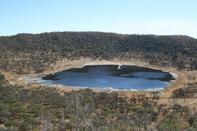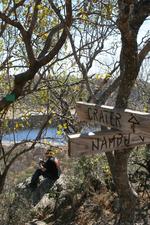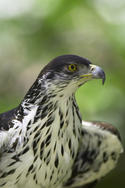Tswaing Meteorite Crater
If you’re a fan of impact sites (and who isn’t?) you simply must visit the Tswaing Meteorite Crater, north of Pretoria. It is a pleasant day trip from Johannesburg and provides an excellent illustration of the forces at work in an impact event.

It is also well-preserved, offering an enlightening counterpoint to the more obscure Vredefort Dome structure. In 2004, the Department of Environmental Affairs and Tourism optimistically nominated Tswaing for World Heritage Status.
Tswaing (meaning ‘place of salt’ in seTswana) is quite a young crater with a simple, bowl-shaped structure, similar in size and shape to Meteor Crater in Arizona. It was formed 220 000 years ago when a stony meteorite, between 30 and 50 metres wide, crashed into the ground at an estimated speed of around 20 km per second (or 72 000 kilometres per hour).
The force generated by the impact would have been 20 to 40 megatons, roughly equivalent to 1000 Hiroshima bombs. Even so, it was a pinprick compared to the Vredefort event. The Tswaing Crater is only 1.3 km wide and 100 metres deep.
A Lethal Rain
Any early humans or animals caught in the vicinity of the impact would have been, well…dead. A lethal rain of ejected rocks and boulders fell over an area over 1000 square kilometres (about the same size as the Greater Johannesburg metropolis) and massive gusts of wind swept across the plain. The shock wave was so extreme it would have caused the lungs of any living creature within a radius of 10 km to explode.
In modern times, as with Vredefort, there was a controversy over the cause of the Tswaing structure. Popular opinion held that the crater had been blasted out of the earth by volcanic activity from below. It was only late in the 20th century that careful examination of core samples from the crater floor revealed characteristic micro-deformations in the crystals, which finally proved that an impact event was responsible for Tswaing.
A Popular Day-Trip

In 1912, a mining concern took over the crater and began extracting soda ash and salt from the lake on a commercial scale. After a rocky start, this venture (South African Alkaki Ltd.) proved very profitable and continued until 1952, when decreasing yields and increasing costs forced the company to close down. Between 1952 and 1992, a succession of companies leased the crater from the government and sent in prospectors, hoping to find one valuable mineral or another.
However, none of these enterprises was particularly successful and the ruins of many old industrial buildings are scattered around the site. Nevertheless, the core samples they dug out of the crater floor did help solve the argument around the crater’s origin.
In 1993, the National Cultural History Museum (now called the Northern Flagship Institute) took control of the farm ‘Zoutpan’ from the Department of Agriculture and began to develop the re-named Tswaing Crater as an educational tourist attraction. At first, facilities were rather basic but, in September 2006, the museum proudly opened the doors on a brand new visitors centre and museum, complete with restaurant and seminar rooms.
The Tswaing Meteorite Crater Museum also offers overnight accommodation for school groups and families, and has become a popular day-trip destination for Gautengers in the know. Braai facilities and a picnic site are available.
The Saltpan
In the centre of the Tswaing Crater stands a shallow lake, rich in carbonates and chloride salts. As this alkaline lake is essentially a closed system with no run-off, the hypersaline water also harbours a healthy population of bacteria and black algae, which give the lake a dark, obsidian appearance.
For thousands of years, the crater lake provided animals and humans with a reliable supply of salt. Local tribes have known of this place since time immemorial and many fragments of broken iron-age pottery have been found along the lake shore.
When white settlers entered the area, they too visited the lake and harvested the precious grains of salt. The government soon got in on the act and began granting concessions to individuals, who then charged the public for access to the crater. The place became known simply as ‘Saltpan’, and several modern road signs still indicate this former name.
A Peaceful Place

A visit to the crater is memorable. Despite the violence of its origin, Tswaing Crater is now a peaceful and attractive place. The steep slopes are covered in trees and a rich variety of birdlife twitters in the hot, bushveld surroundings (240 species have been recorded). A friend of mine said it looked like a scene from Jurassic Park, and expected to see a herd of velociraptors come streaming over the crater rim.
From the viewpoint overlooking the crater, named after pioneering astrogeologist Gene Shoemaker, the scene is unusual and beautiful. The black water of the lake glistens heavily in the sun, and the circular walls of the impact structure rise up on all sides. Standing on the rim, you can almost imagine the momentous moment when the meteorite met the Earth.
To reach the view site, visitors can drive to the edge of the crater (for a small additional fee) and then take a short walk to the lookout point. Alternatively, you can walk the Tswaing Crater Trail, a unique hike that takes you through the 1946 ha conservation area, down the side of the crater, across the crater floor and up the other side. The walk is 7,5 km and is highly recommended. Guided walks are available, by prior arrangement. If you bring your mountain bike, you can also ride the Crater Trail.